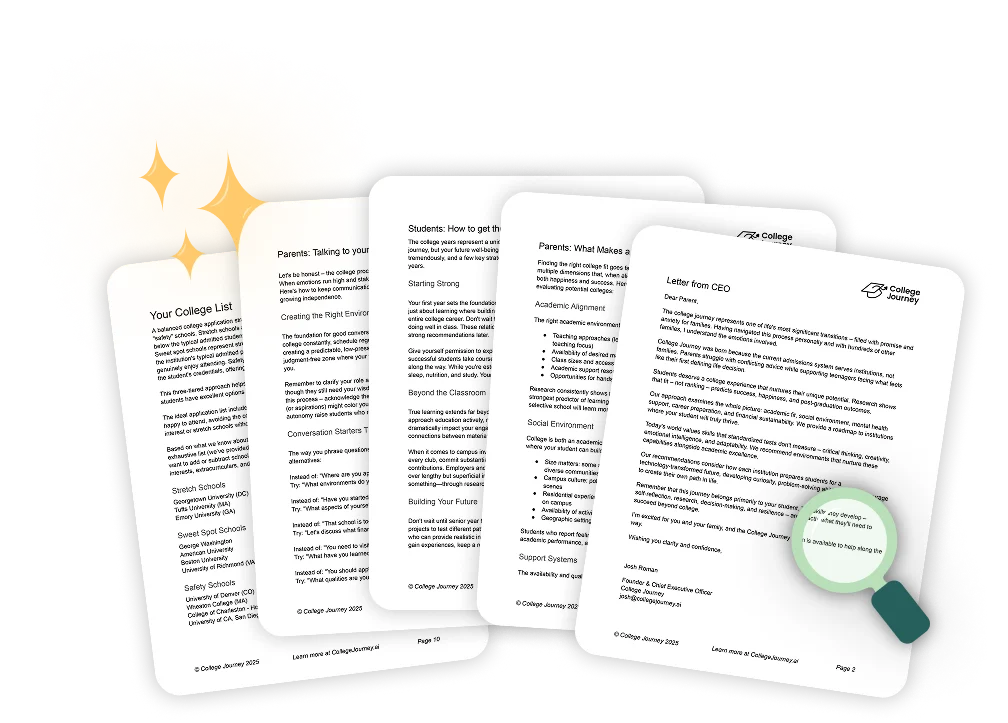A great college essay does more than just check the boxes—it tells a story. But to truly resonate with admissions officers, your college essay needs to flow naturally. A well-flowing college essay moves smoothly from idea to idea, making it easier for the reader to follow your narrative and connect with your voice.
In this article, we’ll explore what it means for an essay to “flow,” why it matters, and how to achieve it through planning, writing, and editing.
Key Takeaways
- A natural flow makes your college essay easier to read and more engaging.
- Essay flow relies on clear structure, strong transitions, and logical progression of ideas.
- Planning your structure before writing helps avoid choppy or disorganized sections.
- Reading aloud and getting feedback are key steps in editing for better flow.
- Avoiding common mistakes—like abrupt topic shifts or overusing fancy transitions—keeps your writing smooth.
What Does It Mean for a College Essay to Flow Naturally?
When a college essay flows naturally, it means your ideas move smoothly and logically from one point to the next, guiding the reader effortlessly through your story. The structure is clear but never rigid, and transitions feel organic rather than forced. Your tone remains consistent, and the language reflects your authentic voice.
This kind of clarity and cohesion doesn’t just make your writing more enjoyable to read—it also sets you apart. According to the U.S. Department of Education, 68% of students entering two-year colleges and 40% of those at four-year public universities needed at least one remedial writing class between 2003 and 2009.
That means many students arrive without fully developed writing skills, making a well-structured, engaging essay a powerful opportunity to stand out.
So, what does natural flow actually look like?
- Logical organization: Each paragraph builds on the last, creating a clear beginning, middle, and end.
- Smooth transitions: Sentences and ideas connect seamlessly, using transitions that feel natural and purposeful.
- Consistent tone: Whether reflective, humorous, or serious, your voice stays steady throughout.
- Clear focus: Every part of your essay contributes to your main idea—without going off track.
When your writing flows, admissions officers don’t get lost or distracted. They stay engaged—and they come away with a clear, memorable impression of who you are.
Why Essay Flow Matters in College Applications
A college essay isn’t just about what you say—it’s about how clearly and convincingly you say it. A well-flowing essay allows admissions officers to follow your story without distraction or confusion. When your writing is easy to read and logically organized, it demonstrates strong communication skills—something colleges value across all disciplines.
This emphasis on clear writing isn’t limited to college admissions. In fact, a study cited by Azusa Pacific University found that 73.4% of employers prioritize strong written communication skills when hiring. That means the ability to write clearly and effectively is not just an academic asset—it’s a long-term advantage.
A disjointed essay, even if it contains a compelling story, can quickly lose the reader’s attention. But when your essay flows naturally, each sentence builds on the last, and every paragraph adds depth and clarity. This keeps the reader engaged and makes your reflections feel more authentic and memorable.
Good flow also adds emotional rhythm to your writing. Like a well-paced novel or film, it draws the reader in, helps them connect with your experiences, and leaves a lasting impression.
In short, flow matters because it turns a simple personal statement into a story that feels alive—one that admissions officers are more likely to remember and appreciate.
Planning Your Essay: How to Create a Smooth Structure
Overwhelmed by college research?
Let us help save time and find the perfect schools for your family.
A smooth, well-organized structure is the foundation of a compelling college essay. Without it, even the best ideas can feel scattered or incomplete. Planning your structure in advance helps your writing flow naturally and ensures that every sentence serves a clear purpose.
In fact, a study published in the English Language Teaching Educational Journal found that 80% of students felt that using an outline improved the clarity and structure of their writing. This highlights just how effective planning can be in turning ideas into cohesive, compelling essays.
Start by identifying the story or message you want to share. Picking the right focus from the beginning makes everything else easier—a well-chosen college essay topic often leads to stronger structure, smoother transitions, and better flow overall. What moment, theme, or insight are you trying to communicate? Once you’ve pinpointed your main idea, use the following structure as a guide:
- Introduction: Begin with a hook—a vivid moment, surprising detail, or reflective question—to draw the reader in. Then introduce the core topic or theme of your essay.
- Body Paragraphs: Each paragraph should explore a different part of your story or perspective. Use smooth transitions to guide the reader from one point to the next.
- Climax or Turning Point: Highlight a moment of change, growth, or realization. This is often the emotional heart of the essay.
- Conclusion: Reflect on what the experience taught you and how it shaped your outlook or character. Tie everything back to your main message.
Think of your essay as a journey: the reader should always know where they are, where they’ve been, and where they’re going next. A well-planned structure not only supports natural flow—it helps bring your story to life. This is one of the first steps in mastering your college essay.
Writing Tips to Improve Essay Flow and Coherence
Even the most compelling story can fall flat if it’s hard to follow. Flow and coherence are what keep your reader engaged—helping your ideas connect smoothly and your voice remain consistent throughout. One way to improve structure right from the start is by decoding your college essay prompt carefully. When you understand exactly what the prompt is asking, it’s easier to organize your ideas in a logical, impactful way.
Once you understand, follow these practical writing tips to improve your essay:
- Use Clear Topic Sentences: Start each paragraph with a sentence that introduces its main idea. This helps guide the reader and keeps your argument or story on track.
- Create Transitions Between Paragraphs: Use transitional words and phrases like “however,” “in addition,” “as a result,” or “more importantly” to connect ideas between paragraphs and signal shifts in focus.
- Avoid Redundancy: Don’t repeat the same point using different words. Instead, build on your ideas to maintain momentum and avoid tiring the reader.
- Vary Sentence Structure: Mix short and long sentences to create a natural rhythm. Too many similar sentence types in a row can make your writing feel mechanical or flat.
- Stick to One Main Idea per Paragraph: Resist the urge to squeeze multiple points into a single paragraph. Keeping each paragraph focused improves clarity and helps with pacing.
- Read Your Essay Aloud: Reading your essay out loud is one of the best ways to catch awkward phrasing, abrupt transitions, or choppy flow. If you stumble while reading, your reader probably will too.
- Use Personal Voice with Purpose: Let your personality come through, but make sure your tone stays consistent. A sudden shift from formal to overly casual can break the reader’s connection.
In fact, a study published in the IOSR Journal of Humanities and Social Science found that 82% of students agreed that outlining before writing improved their paragraph structure and coherence, highlighting the value of prewriting strategies for organizing ideas.
| If you’re working on improving the clarity and rhythm of your writing, these best tips for writing your best college essay can help reinforce structure, tone, and pacing—which are all essential elements for strong flow. |
How to Transition Between Paragraphs and Ideas Naturally
Strong transitions are the glue that holds your essay together. Without them, your writing can feel choppy or disjointed—even if your ideas are strong. Natural transitions guide the reader smoothly from one paragraph or idea to the next, helping your story or argument unfold with clarity and rhythm.
In fact, according to Yoast, their SEO plugin assigns a red light to texts where less than 20% of sentences contain a transition word, indicating that such texts may lack sufficient flow and coherence. To achieve a green light, at least 30% of your sentences should include transition words, underscoring their role in enhancing readability.
Here’s how to make your transitions more effective:
1. Use Transitional Phrases Thoughtfully: Words like “however,” “for example,” “in contrast,” “as a result,” or “furthermore” help signal the relationship between ideas. Use them to show contrast, add support, or indicate cause and effect—without overloading every paragraph.
2. Refer Back to the Previous Point: Start a new paragraph by briefly referencing what came before. This technique creates a bridge and shows logical flow. For example:
“While my love for music began in childhood, it was in high school that I truly developed a sense of discipline.”
3. Maintain Consistent Tone and Voice: Abrupt tone shifts can break the flow. Make sure your transitions match the tone of the surrounding content—whether it’s reflective, narrative, persuasive, or descriptive.
4. Use “Echo Words” or Repeated Themes: Repeating a keyword or idea from the previous paragraph can create a subtle thread that connects your thoughts. This makes your writing feel more cohesive and intentional.
5. Avoid Generic Fillers: Phrases like “That being said” or “In conclusion” can feel mechanical if overused. Opt for transitions that are specific to your content and context.
Transitions aren’t just about style—they’re a key part of how your essay is evaluated. Admissions officers pay close attention to how well your ideas are organized and connected, since what colleges look for in an essay often includes clarity of thought, structure, and logical progression. Strong transitions make those qualities easier to demonstrate.
Editing Techniques to Refine the Flow of Your College Essay
Editing is where your college essay evolves from a rough draft into a polished, impactful story. It’s not just about fixing typos—it’s about refining structure, clarifying your message, and improving how smoothly your ideas connect.
In fact, research shows that thoughtful editing can make a measurable difference. One study found that students who revised their essays over more than five days saw an average improvement of 33.6% in their final grades, compared to just 5.8% for those who edited in five or fewer days. This highlights how taking the time to edit—and doing it well—can have a powerful impact.
Here are practical editing techniques to help you refine the flow of your essay:
1. Read It Aloud
Hearing your words can help you catch awkward phrasing, unnatural transitions, or clunky sentences. If you stumble while reading, revise that section.
2. Check for Logical Progression
Each paragraph should naturally lead to the next. If you notice a jump in logic or a sudden shift in focus, add transitions or restructure as needed.
3. Cut Redundancies
Flow suffers when ideas are repeated. Be concise—make sure every sentence introduces something new or builds on what came before.
4. Balance Sentence Variety
A mix of short and long sentences keeps your writing dynamic. Too many of the same type in a row can feel dull or robotic.
5. Keep Paragraphs Focused
Stick to one main idea per paragraph. If you’re shifting topics mid-way, split the paragraph to improve clarity.
6. Review the Overall Length
Flow also depends on pacing. Staying within a typical college essay length can help your writing feel more intentional and prevent unnecessary tangents.
7. Add Transitions During Revisions
Look for places where your ideas change direction or build on one another. Purposeful transitions help guide the reader through your story without confusion.
A strong edit helps your essay read less like a list of disconnected thoughts and more like a cohesive, compelling narrative. By investing time in refining the flow, you’ll ensure your voice comes through clearly—and leaves a lasting impression.
Final Thoughts: Why Flow Can Make or Break Your College Essay
Crafting a standout college essay isn’t just about what you say—it’s about how well your story unfolds on the page. When your essay flows naturally, admissions officers can focus on what matters most: your ideas, personality, and growth. Clear structure, smooth transitions, and strong editing all work together to make your writing more compelling and easier to follow.
By taking the time to plan, revise, and refine with flow in mind, you don’t just improve your writing—you improve your chances of leaving a memorable impression. Whether you’re reflecting on a personal experience or explaining what drives you, a well-structured and smoothly written essay can elevate your message and help you stand out in a competitive application pool.
Ready to take the stress out of college planning? Join College Journey today for expert guidance tailored to your goals, all without the high costs of traditional consulting. Start your journey toward the perfect college fit – sign up now!
About College Journey
College Journey is your personal college counseling assistant, designed to make the complex college application process simple and stress-free. Powered by Alice, your dedicated AI college counselor, College Journey provides step-by-step guidance, so you never miss a deadline or detail. Whether you’re searching for the perfect school, navigating financial aid, or exploring career paths, Alice has the answers.
With personalized recommendations, school comparisons, and tools to track your progress, College Journey ensures you’re supported at every stage of your college journey. Best of all, it’s free to sign up!
FAQs
What is the purpose of a college application essay?
The college application essay serves as a crucial part of your application, allowing you to showcase your unique personality, experiences, and aspirations to college admissions officers. It provides an opportunity to present a narrative that highlights who you are beyond your grades and test scores.
How do I choose a college essay topic?
Choosing the right college essay topic is pivotal. Start by reflecting on your life experiences, values, and passions. Consider what makes you unique and what stories you want to share with admissions officers. Look for moments of growth, challenges you’ve overcome, or defining experiences that illustrate your character.
What are the key steps to write a perfect college essay?
To write a perfect college essay, follow these key steps:
1) Start by brainstorming ideas that reflect your identity.
2) Create an outline to organize your thoughts logically.
3) Write a draft of your essay, ensuring it flows naturally and captures your voice.
4) Revise your draft, focusing on clarity, structure, and compelling storytelling.
5) Get feedback from trusted sources, and finally, proofread for any grammar or spelling errors.
This comprehensive approach will help you craft an outstanding essay that effectively communicates your message.
How can I make my college application essay stand out?
To make your college application essay stand out, focus on authenticity and specificity. Share personal stories that reveal your character and illustrate your values. Use vivid language and specific examples to engage readers and help them connect with your narrative. Avoid clichés and generic statements; instead, let your voice shine through.
Should I follow a specific format for my college essay?
While there is no strict format for a college application essay, it’s important to maintain a clear structure. Typically, your essay should have an introduction that captivates the reader, body paragraphs that explore your story or argument in depth, and a conclusion that ties everything together.




